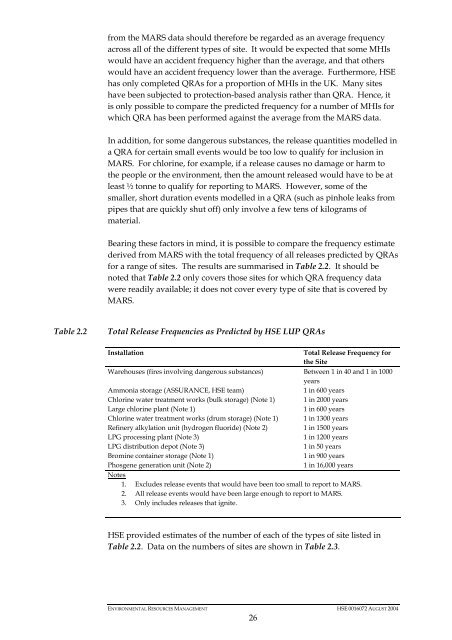A review of HSE's risk analysis and protection-based analysis ...
A review of HSE's risk analysis and protection-based analysis ...
A review of HSE's risk analysis and protection-based analysis ...
Create successful ePaper yourself
Turn your PDF publications into a flip-book with our unique Google optimized e-Paper software.
from the MARS data should therefore be regarded as an average frequency<br />
across all <strong>of</strong> the different types <strong>of</strong> site. It would be expected that some MHIs<br />
would have an accident frequency higher than the average, <strong>and</strong> that others<br />
would have an accident frequency lower than the average. Furthermore, HSE<br />
has only completed QRAs for a proportion <strong>of</strong> MHIs in the UK. Many sites<br />
have been subjected to <strong>protection</strong>-<strong>based</strong> <strong>analysis</strong> rather than QRA. Hence, it<br />
is only possible to compare the predicted frequency for a number <strong>of</strong> MHIs for<br />
which QRA has been performed against the average from the MARS data.<br />
In addition, for some dangerous substances, the release quantities modelled in<br />
a QRA for certain small events would be too low to qualify for inclusion in<br />
MARS. For chlorine, for example, if a release causes no damage or harm to<br />
the people or the environment, then the amount released would have to be at<br />
least ½ tonne to qualify for reporting to MARS. However, some <strong>of</strong> the<br />
smaller, short duration events modelled in a QRA (such as pinhole leaks from<br />
pipes that are quickly shut <strong>of</strong>f) only involve a few tens <strong>of</strong> kilograms <strong>of</strong><br />
material.<br />
Bearing these factors in mind, it is possible to compare the frequency estimate<br />
derived from MARS with the total frequency <strong>of</strong> all releases predicted by QRAs<br />
for a range <strong>of</strong> sites. The results are summarised in Table 2.2. It should be<br />
noted that Table 2.2 only covers those sites for which QRA frequency data<br />
were readily available; it does not cover every type <strong>of</strong> site that is covered by<br />
MARS.<br />
Table 2.2 Total Release Frequencies as Predicted by HSE LUP QRAs<br />
Installation Total Release Frequency for<br />
the Site<br />
Warehouses (fires involving dangerous substances) Between 1 in 40 <strong>and</strong> 1 in 1000<br />
years<br />
Ammonia storage (ASSURANCE, HSE team) 1 in 600 years<br />
Chlorine water treatment works (bulk storage) (Note 1) 1 in 2000 years<br />
Large chlorine plant (Note 1) 1 in 600 years<br />
Chlorine water treatment works (drum storage) (Note 1) 1 in 1300 years<br />
Refinery alkylation unit (hydrogen fluoride) (Note 2) 1 in 1500 years<br />
LPG processing plant (Note 3) 1 in 1200 years<br />
LPG distribution depot (Note 3) 1 in 50 years<br />
Bromine container storage (Note 1) 1 in 900 years<br />
Phosgene generation unit (Note 2) 1 in 16,000 years<br />
Notes<br />
1. Excludes release events that would have been too small to report to MARS.<br />
2. All release events would have been large enough to report to MARS.<br />
3. Only includes releases that ignite.<br />
HSE provided estimates <strong>of</strong> the number <strong>of</strong> each <strong>of</strong> the types <strong>of</strong> site listed in<br />
Table 2.2. Data on the numbers <strong>of</strong> sites are shown in Table 2.3.<br />
ENVIRONMENTAL RESOURCES MANAGEMENT HSE 0016072 AUGUST 2004<br />
26

















